» posted on Sunday, July 22nd, 2012 by Linda Lou Burton
Fish Are Jumping
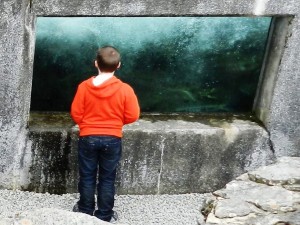 Linda Burton posting from Juneau, Alaska – Sam disappeared before I got across the parking lot. I found him down the ramp, standing transfixed in front of the Fish Ladder. “We’ll see a lot of fish,” I’d promised as we rode to the Hatchery, describing the fish ladder I’d visited so many times in Seattle at the Ballard Locks. But I was unprepared for what I saw as I drew close to this one. These fish were solid packed, jamming the causeway that was their path to fulfilling their life’s mission – the laying of the eggs. Single mindedly, they fought and thrashed for position; drama, in a box of gray cement. But Sam didn’t have all the facts, just yet. We’re at the Salmon Hatchery just outside Juneau on the Gastineau Channel, and we’ve come to see salmon; the Chum are coming through now, we’d heard. So what exactly happens here? Sam and I proceeded up the ramp to begin the tour.
Linda Burton posting from Juneau, Alaska – Sam disappeared before I got across the parking lot. I found him down the ramp, standing transfixed in front of the Fish Ladder. “We’ll see a lot of fish,” I’d promised as we rode to the Hatchery, describing the fish ladder I’d visited so many times in Seattle at the Ballard Locks. But I was unprepared for what I saw as I drew close to this one. These fish were solid packed, jamming the causeway that was their path to fulfilling their life’s mission – the laying of the eggs. Single mindedly, they fought and thrashed for position; drama, in a box of gray cement. But Sam didn’t have all the facts, just yet. We’re at the Salmon Hatchery just outside Juneau on the Gastineau Channel, and we’ve come to see salmon; the Chum are coming through now, we’d heard. So what exactly happens here? Sam and I proceeded up the ramp to begin the tour.
 Billed as an “educational place” the Macaulay Salmon Hatchery Visitor Center offers a birds-eye view of outdoor hatchery operations. We stood on the ramp and watched thousands (maybe millions) of fish thrashing wildly below us, finishing life on a gallant note. Nature, condensed, right before our eyes. Mother Nature designed the life cycle of the salmon as idyllic; born in the cool waters of a shady mountain stream; an eye-opening swim to the sea; a life of adventure in the vast ocean waters. Then the return; go home at last; gently lay your eggs (or fertilize them); rest in peace. That’s the fairy-tale version of a salmon’s life. Here’s the hard-knock story.
Billed as an “educational place” the Macaulay Salmon Hatchery Visitor Center offers a birds-eye view of outdoor hatchery operations. We stood on the ramp and watched thousands (maybe millions) of fish thrashing wildly below us, finishing life on a gallant note. Nature, condensed, right before our eyes. Mother Nature designed the life cycle of the salmon as idyllic; born in the cool waters of a shady mountain stream; an eye-opening swim to the sea; a life of adventure in the vast ocean waters. Then the return; go home at last; gently lay your eggs (or fertilize them); rest in peace. That’s the fairy-tale version of a salmon’s life. Here’s the hard-knock story.
The Spawning. Mama Salmon digs a “redd” in the gravel with her tail while Papa stands watch; they’ve picked a spot below fast-running water so there will be plenty of oxygen for the eggs. Mama lays about 8,000 eggs and Papa covers them with a milky substance known as milt. If this isn’t done within minutes, the eggs die. Mama then covers the eggs with gravel and sits around for several days, on watch. Avert your eyes if you can’t take bad news; then Mama and Papa die. Their decomposing bodies enrich the stream with nutrients for the newborns, that’s their last contribution to the lives of their little ones.
 The Hatch. I would love for Sam and me to see this next part. Several months after the fertilized eggs have grown eyes (you can see them through the translucent shell), they hatch into a tiny creature called an Alevin; huge eyes attached to a bright-orange yolk-sack. Less than an inch long, they can’t swim yet; they only swish their tails around in the gravel. They are growing though; safe and protected from predators.
The Hatch. I would love for Sam and me to see this next part. Several months after the fertilized eggs have grown eyes (you can see them through the translucent shell), they hatch into a tiny creature called an Alevin; huge eyes attached to a bright-orange yolk-sack. Less than an inch long, they can’t swim yet; they only swish their tails around in the gravel. They are growing though; safe and protected from predators.
The Fry, and the Fingerlings. Once they use up that food sack, they begin to look like very small salmon. They can swim, which makes them easy prey for bigger fish. Chinook, King, Pink and Chum Fry head for the ocean right away; Coho, Silver and Sockeye wait about a year. Whenever they begin their migration to the sea, wild salmon are called Fingerlings. An estimated 10 billion salmon fingerlings enter the Gulf of Alaska from surrounding rivers each year. First comes the adjustment, however; it’s called smolting; it’s the physiological and morphological changes that allow them to acclimate to saltwater and takes place in the estuary areas of rivers or streams. Another chance to avert your eyes – only a very small percent of the original salmon ever reach the ocean. Imagine the predators and challenges between egg and ocean! Hungry fish, hungry birds, hungry bears; so many things can go wrong.
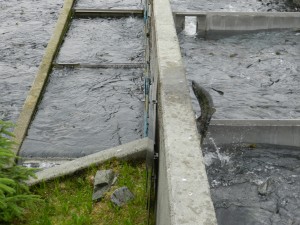 Maturity. The ones that make it have a bountiful life in the feeding grounds off Alaska’s coast; up to five years of eating plankton, tiny shrimp, smaller fish, and squid; moving in the coastal current far from the continental shelf. And then, the Migration. How do they know? Thousands of miles from their birthplace, how do they figure out how to get back home? No AAA, no GPS; scientists surmise the answer is either the stars above, or more practically, their sense of smell. At any rate, they devote all their energy to reach the spawning waters of their birth. Once they re-enter fresh water they stop feeding, living only on stored body fats; they change from sleek silver to red; their body looks humped, their jaw hooked. Their arteries clog; their muscles soften; their skin thickens; all due to changes in blood chemistry, hormones, and enzymes.
Maturity. The ones that make it have a bountiful life in the feeding grounds off Alaska’s coast; up to five years of eating plankton, tiny shrimp, smaller fish, and squid; moving in the coastal current far from the continental shelf. And then, the Migration. How do they know? Thousands of miles from their birthplace, how do they figure out how to get back home? No AAA, no GPS; scientists surmise the answer is either the stars above, or more practically, their sense of smell. At any rate, they devote all their energy to reach the spawning waters of their birth. Once they re-enter fresh water they stop feeding, living only on stored body fats; they change from sleek silver to red; their body looks humped, their jaw hooked. Their arteries clog; their muscles soften; their skin thickens; all due to changes in blood chemistry, hormones, and enzymes.
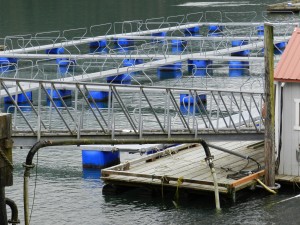 This is what Sam and I see before us today; salmon at the end of the cycle, fighting like crazy to reproduce. In the wild they would be struggling against rapids, waterfalls, fallen logs and rock; here, at the Macaulay Hatchery, the obstacles have been removed. Ladd Macaulay was the visionary behind this place, where approximately 12 million salmon fry in saltwater rearing pens prepare for life at sea. Another 102 million that were born here have been distributed throughout the area; after they complete their next phase of life, about 114 million Chum will be released into the wild. The fish we see in the ladders today will have their eggs removed and fertilized under carefully monitored conditions; the dying fish then sold for fertilizer, or pet food.
This is what Sam and I see before us today; salmon at the end of the cycle, fighting like crazy to reproduce. In the wild they would be struggling against rapids, waterfalls, fallen logs and rock; here, at the Macaulay Hatchery, the obstacles have been removed. Ladd Macaulay was the visionary behind this place, where approximately 12 million salmon fry in saltwater rearing pens prepare for life at sea. Another 102 million that were born here have been distributed throughout the area; after they complete their next phase of life, about 114 million Chum will be released into the wild. The fish we see in the ladders today will have their eggs removed and fertilized under carefully monitored conditions; the dying fish then sold for fertilizer, or pet food.
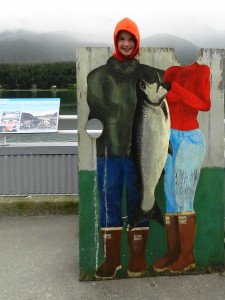 The object, you see, is to increase salmon production. Back in 1979, Macaulay’s beginning efforts returned 30,000 pink salmon to his Kowee Creek Hatchery; a stream that had not seen even one salmon in the previous seven years. Macaulay expanded to Sheep Creek; this hatchery saw him become a major salmon producer – even though his first fish pond was a children’s swimming pool purchased from Sears! The Hatchery we see today was built in 1989 at a cost of $7.4 million. The Visitor Center offers adults and
The object, you see, is to increase salmon production. Back in 1979, Macaulay’s beginning efforts returned 30,000 pink salmon to his Kowee Creek Hatchery; a stream that had not seen even one salmon in the previous seven years. Macaulay expanded to Sheep Creek; this hatchery saw him become a major salmon producer – even though his first fish pond was a children’s swimming pool purchased from Sears! The Hatchery we see today was built in 1989 at a cost of $7.4 million. The Visitor Center offers adults and 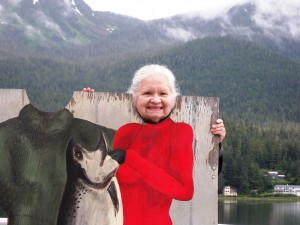 children a chance to learn about salmon; in addition to the tour guide’s explanation of the operations, there is an interesting aquarium inside, a store selling salmon products, and an urban dock outside to provide fishing opportunities.
children a chance to learn about salmon; in addition to the tour guide’s explanation of the operations, there is an interesting aquarium inside, a store selling salmon products, and an urban dock outside to provide fishing opportunities.
Sam and I wandered the place, more than a little awestruck. In the free waters beyond the ladder, fish were jumping. I wish my Dad, and my father-in-law, enthusiastic fishermen all their lives, could see.
Douglas Island Pink and Chum, DIPAC, is a private non-profit organization. All proceeds benefit salmon enhancement and educational programs. Ladd Macaulay Visitor Center, 2697 Channel Drive, Juneau, Alaska 99801, 877-463-CHUM (2486), http://dipac.net/
Note
The salmon industry pumps nearly $1 billion into Southeast Alaska’s economy. Salmon and trout generate one in every ten jobs in the region. Private non-profit (PNP) salmon hatcheries such as this one produce salmon to enhance commercial, sport and subsistence/personal use fisheries.

